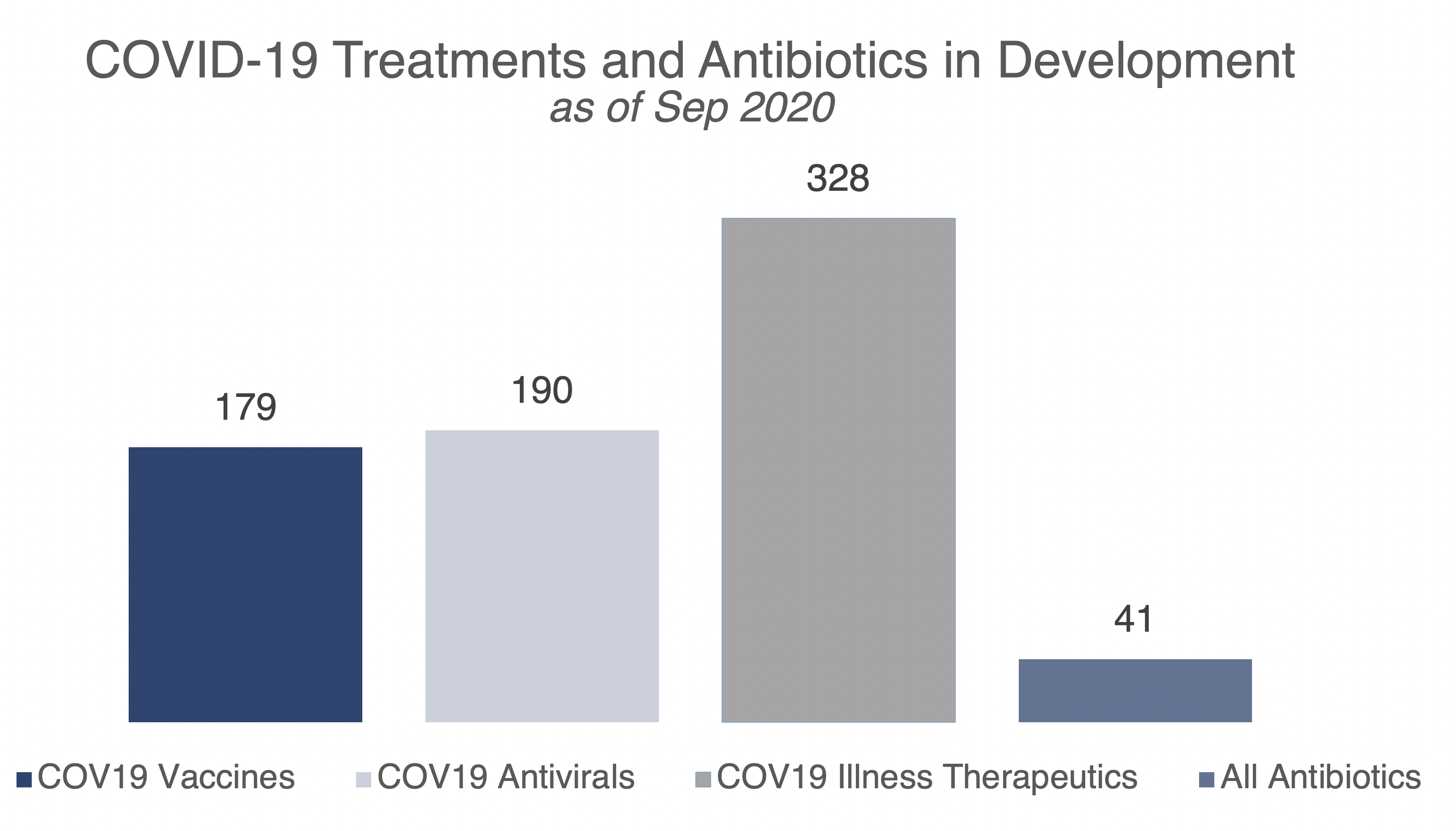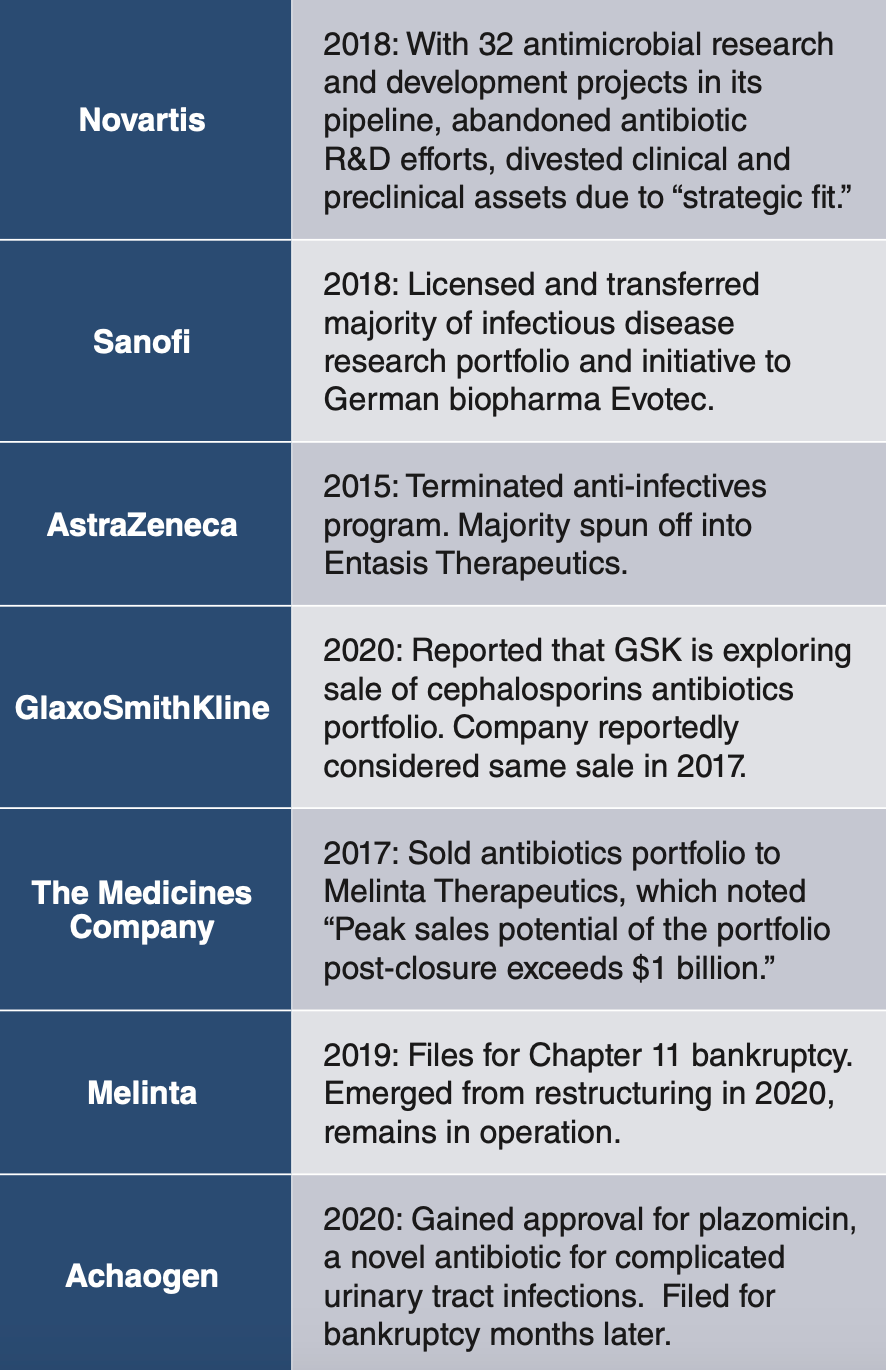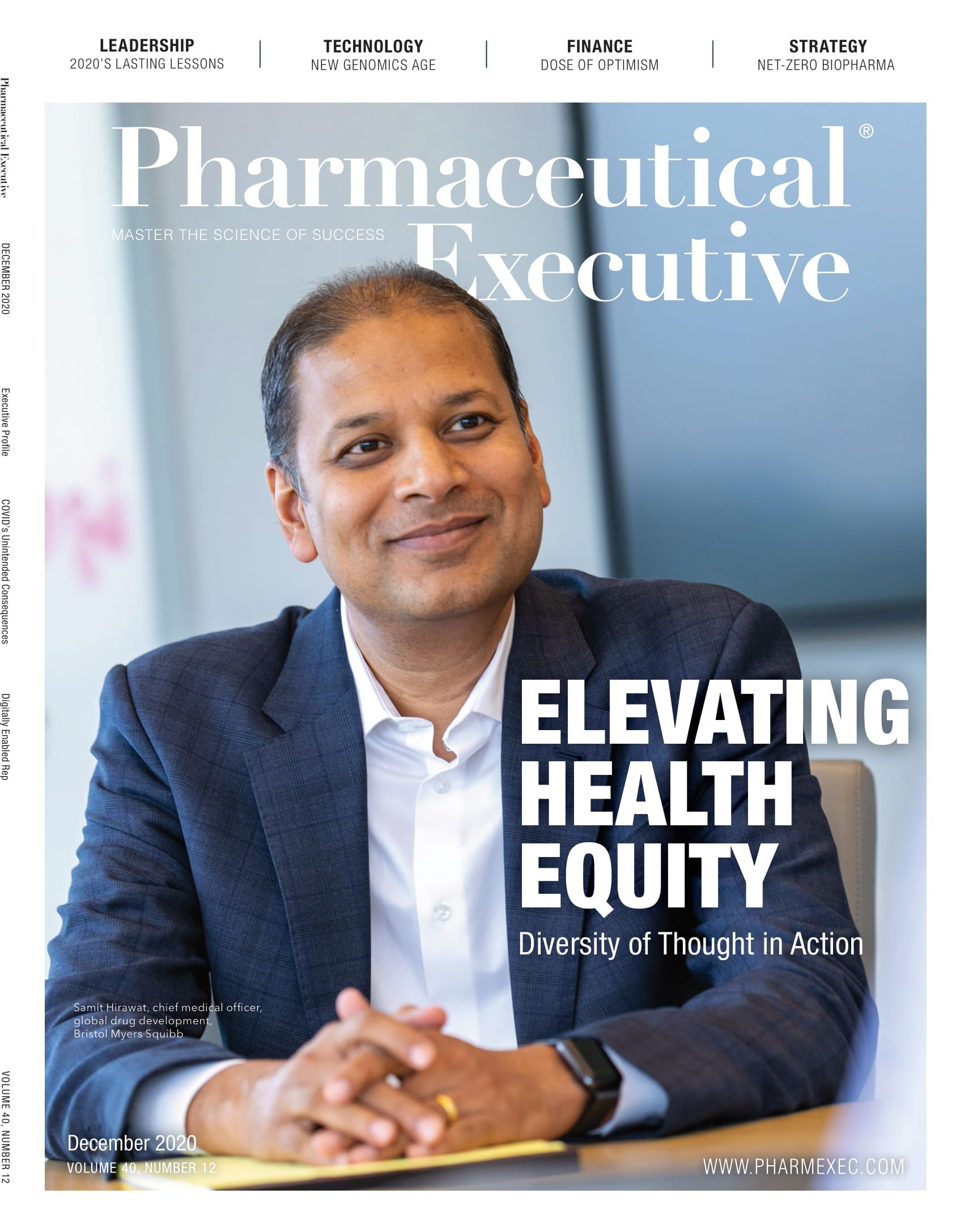COVID and AMR: Crisis Reframes Antibiotics Fight
The redirection of healthcare and life sciences resources to COVID-19 has taken focus from other areas of need, including antimicrobial resistance.
Deepa Dahal

2020 will be long-remembered for the COVID-19 pandemic, which has taken almost 1.5 million lives globally as of Dec. 1. However, another pandemic—drug-resistant bacterial and fungal infections—kills more than 700,000 people each year. Worse still, it is estimated that by 2050, well after SARS-CoV-2 has hopefully been defeated, 10 million people worldwide will die from antimicrobial-resistant (AMR) infections. Consider what this means not just for society, but for life sciences and healthcare writ large: If a given infection cannot be controlled, what treatments and procedures will be unavailable for at-risk populations? Will drugs that reduce the body’s immune response be unapprovable?
Jamie Culp

It is not yet clear how COVID-19 will ultimately impact AMR. Early in the crisis, use of antibiotics including azithromycin and ceftriaxone spiked, and 72% to 92% of patients received antibiotics despite there being no clear evidence that COVID-19 patients are more susceptible to bacterial infections than those with flu-like illnesses.2 Recent reports indicate that antimicrobial stewardship (AMS) is back on track. It is possible that AMS, combined with a concurrent reduction in elective procedures and antibiotics use for outpatient and other indications, has kept overall antimicrobial use relatively flat. However, the redirection of healthcare and life sciences resources to COVID-19 has taken focus from other areas of need, including AMR.
Anti-infectives today: Good intentions and bad incentives
Even after vaccines and treatments bring COVID-19 under control, the challenge of developing effective antimicrobials will not be. Nearly every antibiotic available today is based on scientific discoveries from more than 30 years ago, and the World Health Organization (WHO) has warned that current antimicrobial candidates differ little from what is already available, and that pathogens can easily develop resistance. And while potentially ground-breaking antibiotics (e.g., corbomycin and complestatin) have generated positive results in preclinical testing, the traditional drug approval process means their efficacy and risk/benefit in humans will not be known for years.
Table 1. Source: BIO PACCARB Meeting (click to enlarge)

The issue is not a lack of interest in developing new anti-infectives. As larger pharma companies terminated their programs over the last decade, numerous small companies rose around a novel antibiotic or antifungal (today, small and mid-size pharmaceutical and biotech companies reportedly account for 95% of the antibiotics in development). Several even received regulatory approval and launched therapies with great hope only to fail during commercialization, leaving clinically promising treatments looking for another company willing to take a chance.
How did we get here? In part, good intentions and bad incentives. In recent years, hospitals and healthcare providers have developed antimicrobial stewardship programs (ASPs), and have updated clinical guidelines to administer antimicrobials only after diagnostic tests confirm an infection and only for as long as necessary. While these actions have likely reduced the progress of AMR, they have also reduced the economic incentives of antimicrobial development.
Commercial models: Fixing push and pull incentives
Understanding that the commercial model for antimicrobials is broken, what is the fix? Efforts underway include the industry-funded AMR Action Fund, which aims to bring two to four new antibiotics to market this decade, through nearly $1 billion in funding for the challenging late stages of development. The Fund will also supply essential clinical and commercialization expertise.Since 2016, the public-private partnership CARB-X has invested more than $250 million in preclinical and early-stage antibiotics targeting the most dangerous drug-resistant bacteria.
Table 2. Sources: Published reports/releases from STAT, Evotec, FiercePharma, Melinta (click to enlarge)

Push efforts like these, though valuable, are only a bridge. Ultimately, pull incentives must be updated to ensure a sustainable antimicrobial pipeline—and that requires new public policy.
In the US, the 21st Century Cures Act, passed in 2016, codified new provisions for antimicrobial innovation and stewardship.This includes the Limited Population Pathway for Antibacterial and Antifungal Drugs (LPAD), which provides drugs targeting “serious or life-threatening infections in limited populations of patients with unmet needs” with a streamlined development path, including smaller and/or fewer clinical trials. So far two treatments—Arikayce for refractory Mycobacterium avium complex (MAC) lung disease, and pretomanid for a type of highly treatment-resistant tuberculosis—have been approved through LPAD.
By definition, LPAD addresses a limited need—larger fixes require additional legislation. The Developing an Innovative Strategy for Antimicrobial Resistant Microorganisms Act of 2019 (DISARM Act) would increase Medicare reimbursement for new antimicrobials—specifically those targeting “resistant, novel, or emerging infectious pathogens.” With 63 million Americans currently covered by Medicare alone, and 40% of Medicare spend going to hospital services,DISARM represents a significant economic incentive, especially to smaller anti-infectives developers.
The Pioneering Antimicrobial Subscriptions To End Upsurging Resistance Act of 2020 (PASTEUR Act) would provide developers of critical need antimicrobials with up to $3 billion to support preclinical and clinical trials, manufacturing, post-marketing obligations, and more. This could empower companies to develop treatments for areas of highest need rather than the highest profit.
Until legislation like this becomes law, regulatory changes like the Centers for Medicare and Medicaid Services (CMS) updated Hospital Inpatient Prospective Payment System (IPPS) may be the best hope for improved reimbursement of anti-infectives. Under the new rule, a qualified anti-infective is eligible for the New Technology Add-On Payment (NTAP) without meeting the “substantial clinical improvement” criterion—a heavy burden since many new antibiotics are approved based on non-inferiority.
In Europe, the EU PRIME scheme facilitates development of medicines for unmet needs, including anti-infectives. It provides a supportive and accelerated approval assessment to bring effective treatments to market sooner.
The EU’s Innovative Medicines Initiative launched New Drugs Bad Bugs in 2013 with €600 million to support development of new anti-infectives—specifically antibacterial agents for gram-negative antibiotic resistant pathogens. But pull-through incentives were not within its scope.
As in the US, most EU countries use diagnosis-related group (DRG) for hospital reimbursement—and pricing for anti-infectives is based on generics. While EU authorities recognize the need for novel reimbursement systems, and schemes including DRG carve-outs and exclusivity vouchers have been proposed, thus far only Sweden and the UK have committed to pilot pull incentives, paying the innovator an annual fee in return for an access guarantee.
Case study
One developer carving a path through this rugged landscape is Entasis Therapeutics, which was spun out of AstraZeneca’s terminated anti-infectives program in 2015. Entasis CEO Manos Perros, PhD, has noted the need for a new approach to anti-infectives development and commercialization, with recalibrated incentives and payment models, and coordinated action between industry, government, prescribers, and other stakeholders. Their four-drug pipeline is focused on multidrug-resistant infections classified by the WHO and CDC as the most serious public health threats in need of effective treatments. The company also partners with NIH and has received multiple awards from CARB-X to support development. Two antibiotics—one indicated for acinetobacter infection and another for uncomplicated gonorrhea—are currently in Phase III trials. As with most clinical-stage biopharmas, Entasis is not yet profitable, but states it has sufficient cash to operate through at least Q4 2021.
Table 3. Source: WHO priority pathogens list for R&D of new antibiotics, 2017. CDC: Antibiotic Resistance Threats in the United States, 2019 (click to enlarge)

The role of Patients in antibiotic development, AMR management
Important allies in the fight against AMR are patients, caregivers, and patient advocates. As an example, the Cystic Fibrosis Foundation has a vested interest in preventing AMR, as people with cystic fibrosis (CF) are highly susceptible to chronic infections from bacteria colonies that develop biofilms which allow them to evade the immune system and resist antibiotic treatment. In 2018, the CF Foundation dedicated $100 million to advance infection research, including the growing issue of antibiotic resistance.
COVID-19 has drawn new attention to AMR. Karen Matthews, 47, a molecular biologist and member of the LongCovidSOS patient support group, experienced first-hand the anxiety of making treatment decisions when confronting a novel disease. “I was offered antibiotics several times. I asked my doctor, ‘Do I really need these, is this going to affect my health?’ I know resistance is an issue…but it doesn’t matter how knowledgeable you are… when you are severely ill, you are ready to accept anything. You’re vulnerable, and that’s when we need the medical professionals to test for bacterial infection and be more careful when prescribing antibiotics.” Likewise Helen, 54, who was hospitalized for COVID in March and is still in recovery, said, “I think we [patients] still don’t have an awareness of the repercussions of overusing antibiotics…of course with COVID-19 you want anything and everything thrown at you because you’re afraid you’re going to end up on a ventilator or worse.”
If we are to overcome AMR, it is essential that the voices of these and other patients be heard and integrated into our efforts.
No time to rest
It appears clear now that COVID-19 will be overcome, thanks to the tireless work of front-line healthcare workers, the unprecedented dedication of time and resources by the life sciences industry, and the actions of citizens worldwide to stop the virus’ spread. Once the pandemic is declared over it would be understandable to take a breath and believe all is well. But that would be a mistake, as resistant pathogens will not rest and will only grow stronger if left unchecked. Will society and its leaders take the lessons of the COVID-19 pandemic and apply it to AMR in time?
References
- World Health Organization (WHO). No Time to Wait: Securing the future from drug-resistant infections. Apr 2019.
- Srinivasan A. The Intersection of Antibiotic Resistance (AR), Antibiotic Use (AU), and COVID-19 for the Presidential Advisory Council on Combating Antibiotic-Resistant Bacteria. CDC. Sep 2020.
- Balkhy H. International Perspective on COVID-19 and AMR: Presentation for the Presidential Advisory Council on Combating Antibiotic-Resistant Bacteria. WHO. September 2020.
- Gibson P. Important lessons from COVID-19 battle for war on Antimicrobial Resistance, says think tank. Antibiotic Research UK. Sep 2020.
- Clancy C. COVID-19 Mortality from Secondary Acquired Infections. Presidential Advisory Council on Combating Antibiotic-Resistant Bacteria. Sep 2020.
- BIO PACCARB Meeting
- Antibiotics Currently in Global Clinical Development, Pew Charitable Trusts, Apr 2020.
- The small-molecule antibiotics pipeline: 2014–2018. Nature Reviews Drug Discovery, Oct 2019.
- WHO. Lack of new antibiotics threatens global efforts to contain drug-resistant infections. Jan 2020.
- McMaster University. Antibiotics discovered that kill bacteria in a new way. ScienceDaily, Feb 2020.
- Pew Charitable Trusts. Tracking the Global Pipeline of Antibiotics in Development, Apr 2020. https://www.pewtrusts.org/en/research-and-analysis/issue-briefs/2020/04/tracking-the-global-pipeline-of-antibiotics-in-development, accessed Nov 17, 2020.
- Silverman E. Novartis is the latest big drug maker to exit antibiotic research. STAT, Jul 2018.
- Evotec and Sanofi sign definitive agreement to combat infectious diseases. Evotec news release, June 2018.
- Perros M. Wanted: better policies and incentives to revitalize R&D for new antimicrobial drugs. STAT, Oct 2019.
- Liu A. GlaxoSmithKline looks to sell some antibiotics in renewed portfolio shakeup: report. FiercePharma, Mar 2020.
- Melinta Therapeutics Enters Into Agreement to Acquire Infectious Disease Business from The Medicines Company. Melinta news release, Nov 2017.
- Melinta Therapeutics Successfully Completes Financial Restructuring. Melinta news release, Apr 2020.
- ZEMDRI (plazomicin) Prescriber Information
- Keshavan M. Fixing a ‘market failure’: To develop new antibiotics, upend the incentive structure, experts urge. STAT, May 2019.
- Antibiotic Stewardship Statement for Antibiotic Guidelines – Recommendations of the HICPAC, Dec 2018.
- Economic Incentives Needed to Fix the Broken Antibiotic Market, Pew Charitable Trusts, https://www.pewtrusts.org/en/research-and-analysis/articles/2019/10/04/economic-incentives-needed-to-fix-the-broken-antibiotic-market
- AMR Action Fund, https://amractionfund.com/amr-innovation-challenge/#page-section-1. Accessed Nov 13 2020.
- CARB-X, https://carb-x.org. Accessed Nov 13 2020.
- 21st Century Cures Act, 2016. United States Congress / Governmental Publishing Office. https://www.congress.gov/114/plaws/publ255/PLAW-114publ255.pdf. Accessed Nov 13, 2020.
- Limited Population Pathway for Antibacterial and Antifungal Drugs – the LPAD Pathway. FDA. https://www.fda.gov/drugs/development-resources/limited-population-pathway-antibacterial-and-antifungal-drugs-lpad-pathway. Accessed Nov 13, 2020.
- DISARM Act of 2019. United States Congress / Governmental Publishing Office. https://www.congress.gov/bill/116th-congress/house-bill/4100/text. Accessed Nov 13, 2020.
- MacDonald J. The DISARM Act Proposes New Strategies to Fight The Growing Threat Of Antibiotic Resistance. Infection Control Today, October 2019.
- PASTEUR Act of 2020. United States Congress / Governmental Publishing Office. https://www.congress.gov/bill/116th-congress/senate-bill/4760/text?r=2&s=1. Accessed Nov 13, 2020.
- Fiscal Year (FY) 2020 Medicare Hospital Inpatient Prospective Payment System (IPPS) and Long Term Acute Care Hospital (LTCH) Prospective Payment System (CMS-1716-F). https://www.cms.gov/newsroom/fact-sheets/fiscal-year-fy-2020-medicare-hospital-inpatient-prospective-payment-system-ipps-and-long-term-acute-0, accessed Nov 13, 2020.
- Dall C. Medicare payment changes aim to boost antibiotic development. Center for Infectious Disease Research and Policy, Aug 2019.
- PRIME: priority medicines. European Medicines Agency. https://www.ema.europa.eu/en/human-regulatory/research-development/prime-priority-medicines, accessed Nov 14, 2020.
- European Commission. Action Plan Against the rising threats from Antimicrobial Resistance: Road Map. Updated 2016.
- Årdal C et al. Financing Pull Mechanisms for Antibiotic-Related Innovation: Opportunities for Europe, Clinical Infectious Diseases, Oct 2020.
- European Centre for Disease Prevention and Control. Proposals for EU guidelines on the prudent use of antimicrobials in humans, 2017.
- WHO priority pathogens list for R&D of new antibiotics. 2017. https://www.who.int/news/item/27-02-2017-who-publishes-list-of-bacteria-for-which-new-antibiotics-are-urgently-needed, accessed Nov 14, 2020.
- CDC. Antibiotic Resistance Threats in the United States, 2019
- Entasis Therapeutics Pipeline. https://www.entasistx.com/pipeline, accessed Nov 14, 2020.
- Entasis Therapeutics Receives Second CARB-X Award, Providing up to $10.1 Million for Development of Non-Beta-lactam PBP Inhibitor Program. Oct 2017. https://investors.entasistx.com/news-releases/news-release-details/entasis-therapeutics-receives-second-carb-x-award-providing-101, accessed Nov 14, 2020.
- Entasis Therapeutics Reports Third Quarter 2020 Financial Results and Provides a Business Update. Nov 2020. https://investors.entasistx.com/news-releases/news-release-details/entasis-therapeutics-reports-third-quarter-2020-financial, accessed Nov 14, 2020.
- Cystic Fibrosis Foundation. Infection Research Initiative. https://www.cff.org/Research/Research-Into-the-Disease/Research-into-CF-Complications/Infection-Research-Initiative, accessed Nov 19, 2020.
- Patient interviews conducted by DKI Health Oct 2020.
Deepa Dahal, Executive Partner, Jamie Culp, Strategic Engagement Director; both with DKI Health

Cell and Gene Therapy Check-in 2024
January 18th 2024Fran Gregory, VP of Emerging Therapies, Cardinal Health discusses her career, how both CAR-T therapies and personalization have been gaining momentum and what kind of progress we expect to see from them, some of the biggest hurdles facing their section of the industry, the importance of patient advocacy and so much more.
Applying Porter’s Five Forces to Portfolio Management in Pharmaceutical R&D: A Strategic Roadmap
March 17th 2025The increasing costs and complexity of R&D in the pharmaceutical industry have necessitated the adoption of strategic portfolio management to optimize resource allocation and enhance competitive advantage.